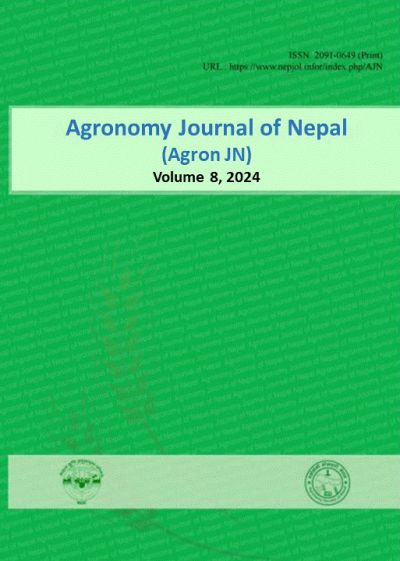Performance of Black gram (Vigna mungo L. Hepper) under Different Levels of Phosphorus at Bardiya, Nepal
DOI:
https://doi.org/10.3126/ajn.v8i1.70858Keywords:
Economic analysis, flower bud count, harvest index, nodules, root lengthAbstract
A field experiment was conducted during the spring season of 2023 in Badhaiyatal Rural Municipality-7, Bardiya district to evaluate the performance of black gram at various levels of phosphorus. A randomized complete block design (RCBD) consisting of four treatments and five replications were used for the study. The treatments consisted of different levels of phosphorous viz. 0 Kg ha-1 (control), 20 Kg ha-1, 40 Kg ha-1 and 60 Kg ha-1. Black gram var. BLG 0093-1 was sown at spacing of 40 cm x 5 cm in the plots sized 8 m2. All the growth parameters and yield obtained from each treatment were compared at 5% level of significance. The results showed significantly greater number of branches (13.84), flower buds (11.33), root length (16.27 cm) and secondary roots (16.05) at 60 Kg phosphorus per ha followed by 40 Kg ha-1. However, plant height, pods per plant, seeds per pod, weight of pods per plant, biomass and grain yield showed non-significant results at similar levels of phosphorus (60 Kg ha-1). Though non-significant, higher number of fruiting branch, number of nodules, effective nodules, 1000 grain weight and harvest index were observed at 40 Kg ha-1 phosphorus. The findings suggested a gradual increase in the yield with increasing levels of phosphorus with the highest gross return from 60 Kg ha-1 phosphorus. However, since the variation in grain yield among the treatments was not significant, the cost involved with the 60 Kg ha-1 was greater as compared to 40 Kg ha-1 phosphorus, greater benefit was observed with the latter. So, on grounds of greater net return and better BC ratio, 40 Kg ha-1 phosphorus seems to be more profitable for the farmers.
Downloads
Downloads
Published
How to Cite
Issue
Section
License
Copyright (c) 2024 Agronomy Society of Nepal (ASoN)

This work is licensed under a Creative Commons Attribution-NonCommercial 4.0 International License.
ASON permits for free use, distribution and reproduction in any medium if the original work is properly cited and not used for commercial purposes.




